formula1.com
06 Jan 2016 . Future vision - the F1 car, 2017 style
As excitement builds around the start of the 2016 season, Formula One engineers and designers already have one eye firmly fixed on 2017, when significant changes to the F1 rule book will dramatically alter the appearance of the cars, making them both wider and faster. The exact regulations may not yet be finalised, but with the help of drawings from technical illustrator Giorgio Piola, we take a look at how next year’s machines could look if recent proposals come to fruition...
The overhead comparison above highlights the key areas of change. Starting from the front, the nose of the car (1) is 20cm longer than in 2016, while the width of the front wing increases from 165cm to 180cm. However, the wing’s new delta shape means the distance between the front tyre and the endplate (2) remains unchanged, as does the endplate size.
The tyres are wider, with tread width up from 24.5 to 30cm at the front (3) and from 32.5 to 40 at the rear (8). This in itself is expected to make cars around three seconds per lap quicker. Meanwhile, the overall width of the car increases from 140cm to 180cm.
Restrictions on floor surface area means that rearward of the front of the cockpit (5) the car cannot be the maximum 180cm wide for its entire length (6), so there must be a cut-out at some point (7). Another proposal prescribes a minimum body width of 160cm at all points, which means the cut-out cannot be more than 10cm deep. Finally, the rear wing (9) is wider - up from 80cm to 95cm - with a bigger overhang.
Looking at the 2016 and ’17 cars front-on, we can see that the rear wing is not only wider, but also lower. The drawing above also highlights the increased width of the tyres (2), the car itself (3), and the front wing (4).
A similar comparison from the rear of the cars again makes clear the lower and wider rear wing (1/2) and the wider rear tyres. It also shows us another change: an increase in the permitted height of the rear diffuser, up from 12.5 to 22cm.
It is not only the height of the rear diffuser that is different. More importantly, the side-on comparison drawing above shows that instead of starting from the rear axle, the diffuser starts 33cm in front of it (6). As well as the nose (1) and front wing (2) changes, this drawing also shows the return of large turning vanes (3) between the front tyres and the sidepods, as well as highlighting the bigger rear wing (5) with its larger overhang, which will help boost ground effect.
|
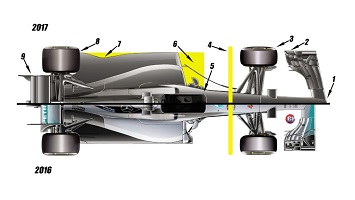
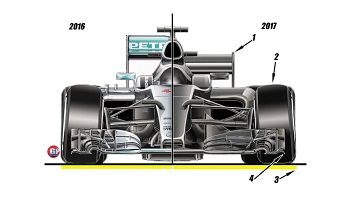
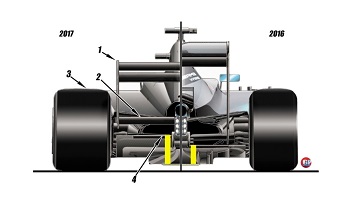
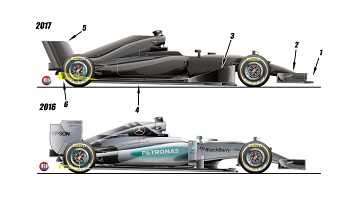
|
formula1.com
10 Feb 2016 . Analysis - the radical power unit changes set to boost Ferrari in 2016
Ferrari are set to make a raft of changes to their car for 2016, including the introduction of pushrod front suspension, a shorter nose (which falls somewhere between what Mercedes and Toro Rosso used in 2015), lower sidepods with a narrower ‘coke bottle’ rear end, and a narrower gearbox.
But the most important and radical innovations are in the layout of the Italian team’s power unit.
Ferrari have not held back over the winter, making modifications to almost every component - indeed only the MGU-H (2) remains in the same position as in 2015.
On the engine side, Ferrari will follow Mercedes' lead and adopt variable inlet trumpets (5) for the first time. This change, which will allow better tuning of the air/fuel mixture during combustion, is possible because the large intercooler (1, top drawing) used last year has been removed from the ‘V’ of the engine and replaced with two smaller intercooler elements (1, bottom drawing).
Between them, these elements (one of which will be situated on top of the fuel tank and the other on the left sidepod) will ensure that the engine has the cooling needed to maximise its extra power.
To ensure that they can use a very narrow gearbox - a potential advantage aerodynamically - Ferrari have moved the MGU-K (3) and placed it low down on left side of the engine (as it is in all other manufacturers’ units). The new oil tank (4) meanwhile is both lower and wider than before, offering a potential improvement to the car's centre of gravity, while the clutch (6) is no longer in the engine but inside the gearbox bellhousing.
Will these changes provide the silver bullet Ferrari are looking for? The answer to that remains to be seen, but in theory they won't just see an upswing in power unit performance, they'll see aerodynamic benefits too as the revised layout will also allow them to run much more aggressive packaging at the rear.
|
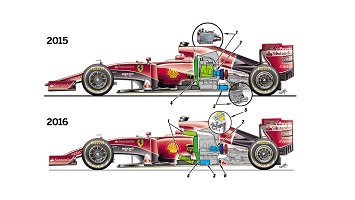
|
formula1.com
22 Feb 2016 . Analysis - what’s new on the Ferrari SF16-H?
For 2016 Ferrari have finally moved to a short nose design (2), very similar to Red Bull’s, which will aid airflow under the car. For launch the team have retained last year’s front wing (1), as well the blown front axle. The shape of the chassis (3) is now much higher and straighter, with a vanity panel possibly intended for a future S-duct solution. The sidepods (4) are taller and more blended with the chassis in order to respect the revised regulations requiring cockpit head protection to be 2cm higher. There are 10 small hot air vents beside the cockpit (5) and the airbox is now more oval in shape and higher relative to the driver’s helmet. The new engine cover shape features what could be a small inlet for the engine manifold (6).
At the rear of the car the long sidepods (7) are very low, with all the hot air from them expelled in the rear suspension area. The lower portion of the car’s rear (8) is very narrow thanks to a more compact gearbox design, which no longer contains the MGU-K but does feature an innovative clutch position (see related article below). The rear of the engine cover (9) is also lower and different in shape to the SF15-T’s. For launch, as at the front, the rear wing design (10) is from the end of the 2015 season.
In the front-on drawing above, you can clearly see the aforementioned shorter nose design, with its more complex, vertical front wing pillars. Also visible is the more rounded airbox shape, and the move from pullrod to pushrod front suspension - highlighted in more detail in the final drawing below.
|
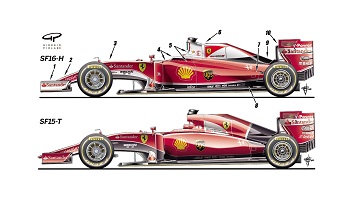

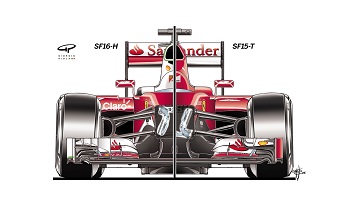
|
formula1.com
25 Feb 2016 . Analysis - the 2017 bodywork proposals explained
Longer, lower, wider - that is what Formula One cars are expected to become next year thanks to bodywork rule changes revealed by the FIA this week...
With the help of technical illustrator Giorgio Piola, we bring you a visual explanation of the exact changes - changes that are predicted to increase speeds by around three seconds per lap...
|
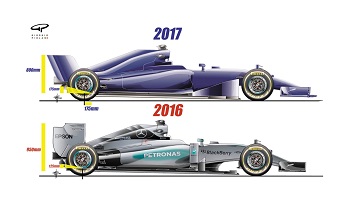
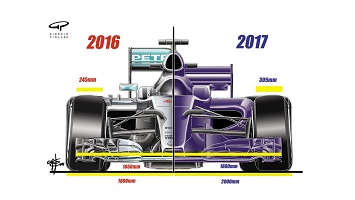
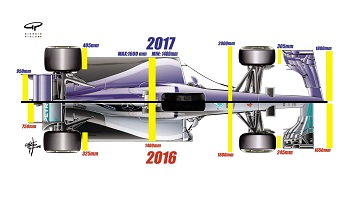
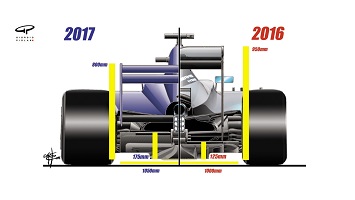
|
formula1.com
29 Feb 2016 . Technical analysis - slotted bargeboards, suspension aero, S-duct evolution
Slotted bargeboards
Mercedes' F1 W07 Hybrid was not only incredibly reliable at the first test, the team were also the first team to introduce radical new design solutions when compared to the car seen at launch. Among them were these innovative bargeboards, with numerous vertical slots and finger-shaped vortex generators (red arrows) at the base of the slots. The whole design highlights the in-depth efforts being made to manage the airflow feeding under the floor to the car’s rear diffuser.
Front suspension aerodynamics
The trend of giving a tuning fork-like shape to the front suspension’s lower wishbone was established by Mercedes in 2014. The conjoined wishbone in effect becomes a large aerofoil, reducing the turbulence created as airflow passes through. Modifying suspension elements in this way is perfectly legal as long as they do not exceed the permitted 3.5:1 depth-to-thickness ratio. Ferrari and Force India followed the trend in 2015, and now it can also be seen on the Red Bull (shown here), Haas and Toro Rosso.
McLaren have gone down a slightly different route. The MP4-31's suspension elements do have an aerodynamic design, but the pick-up points of the upper and lower wishbones’ rear legs are now very close together (highlighted in yellow). This not only aids the car’s anti-dive characteristics under braking, it also means the elements act together to increase their aero influence in managing the airflow under the sidepods.
S-duct evolution
The S-duct was reintroduced to Formula One racing by Sauber in 2012, copied by Red Bull in 2013 and then also adopted by McLaren and Force India last year. For 2016 Toro Rosso have taken a slightly different approach on their STR12, with all the ducting neatly contained within the nose rather than mounted in front of the chassis bulkhead, effectively moving the whole S-duct forward slightly. Air is drawn in through two NACA-style ducts in either side of the nose, and then ejected through the letterbox slot on top.
|
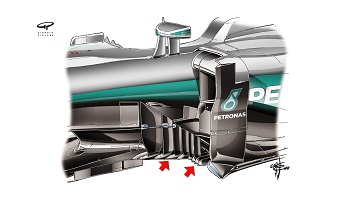
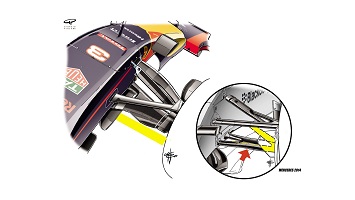

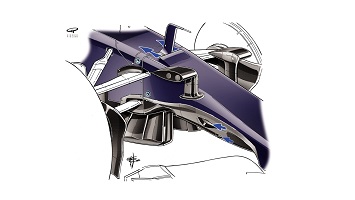
|
formula1.com
10 Mar 2016 . Technical analysis - how Mercedes and Ferrari showed their ‘teeth’ in testing
Adding a serrated edge to a wing flap is nothing new, but this year in testing Mercedes and Ferrari both revived the trend. We explain why…
Engineering a Formula One car, especially in an era of rule stability, is all about finding marginal gains, and it would appear that that’s just what Mercedes and Ferrari were trying to do in testing as they assessed the merits of running serrated edges on their rear wings - a solution that, when used properly, can improve aero efficiency.
The Silver Arrows’ experiments with serrations began at the tail-end of last year. In Suzuka the team introduced serrations to their front wing flap (see picture below), while later they began testing the benefits of using a serrated pattern on the trailing edge of the rear wing main plane.
This idea was trialled again during pre-season testing in Barcelona, and on the last day of running a new rear wing main plane and top flap was introduced (see picture below), similar to that used by McLaren at Hockenheim in 2014 (inset, top picture).
The thinking behind this design is to improve efficiency by reducing airflow separation and to allow airflow to reattach more easily once the DRS wing flap has reverted back to the standard position.
Ferrari’s experiments with serrations meanwhile, mirrored, what Williams ran at Monza in 2004 - a serrated Gurney flap on the trailing edge of the top flap (see below).
This solution helps to create mini vortexes which should reduce drag and increase efficiency, however the Scuderia only kept the design on the SF16-H for the first morning of the second test.
Will they use it at a race weekend in 2016? Watch this space…
|
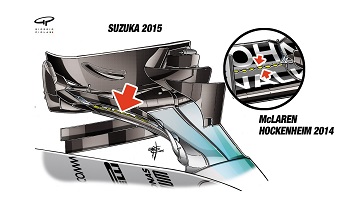
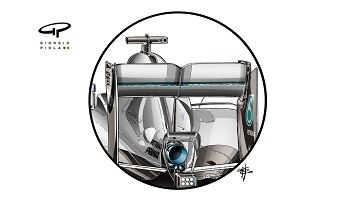
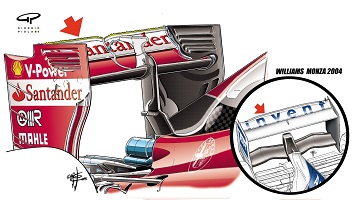
|
formula1.com
20 Mar 2016 . Analysis - the single-clutch race start returns
Amid FIA-imposed changes designed to force more control away from engineers and back into the hands of the men at the wheel, this season sees drivers limited to using just one hand to operate single-paddle clutches for race starts.
No longer permitted is the use of the double-paddle clutch systems that had assisted drivers' standing starts in recent years, with the second clutch almost acting as a form of traction control, as highlighted below in the animation from renowned F1 technical illustrator Giorgio Piola.
Two paddles are still allowed, but only may be used for the start. There must be no interaction between the two paddles, and each must be operable by only one hand.
The changes follow the introduction at last year’s Belgian race of tighter restrictions on clutch bite-point finders. Inevitably, each team has come up with slightly different solutions, with some retaining dual-paddle set-ups behind the steering wheel, and others moving to a single paddle.
As shown in the drawing above, Ferrari fall into the latter camp. Compare the wheel from last year’s SF15-T machine on the left to that of the new SF16-H on the right.
|
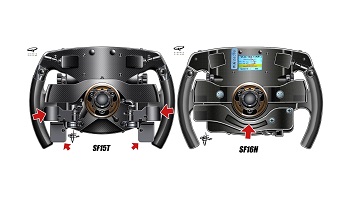
|
formula1.com
21 Mar 2016 . Analysis - tech insights from Australia
McLaren TV camera mountings
Aerodynamic research is being pushed to extreme limits this year as teams look to eke out an advantage in a period of relative rules stability. The result is solutions like this one on McLaren’s MP4-31, where for the first time the team have added a slot (red arrow) to the nosecone’s camera mountings in order to better channel air to the central section of the car.
Ferrari front wing updates
For Melbourne Ferrari retained the new front wing introduced on the SF16-H at the final Barcelona test, with a slightly serrated first flap (red arrow), and a small vortex generator (black arrow) on the innermost vertical fin in the upper flap section, designed to better manage the large vortex generated by the front wing.
Toro Rosso S-duct
This drawing shows in detail the airflow (blue arrows) through the innovative S-duct on Toro Rosso’s STR11. The large NACA duct on the side of the nose feeds the vertical ramp (as on other teams’ machines) that allows air to pass from the side to the top of the nose. Meanwhile, the smaller NACA duct on the base of the nose (immediately below the large duct) allows air inside the chassis, probably for the purpose of cooling electronics boxes.
Ferrari rear suspension
Ferrari have retained the usual pull-rod configuration for their 2016 car's rear suspension, but its placement has been changed to allow for easier access via the removal of just a small section of the engine cover. The drawing above highlights the differences between last season's SF15-T (top) and the new SF16-H (bottom). The new machine also has a very slightly shorter wheelbase, reduced by less than an inch over its predecessor.
|
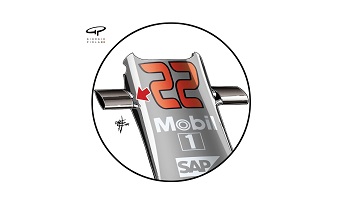
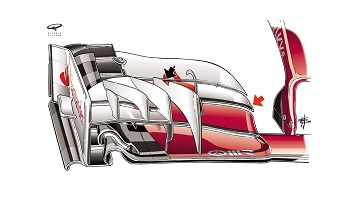
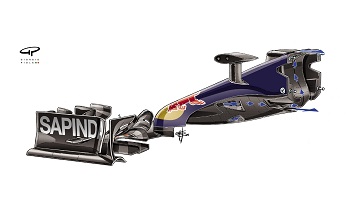
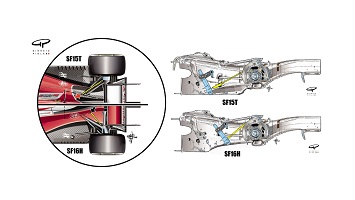
|
formula1.com
01 Apr 2016 . Analysis - the inner workings of Mercedes’ S-duct
Originally introduced to Formula One racing by Sauber in 2012 to improve airflow efficiency at the front of the car, the S-duct remains an ongoing source of fascination for the F1 designer - and hence continues to evolve in ever more intricate fashion.
This drawing from renowned technical illustrator Giorgio Piola shows us the rear of the Mercedes nosecone and highlights how the side openings at the front of the nose create two separate channels for the incoming airflow.
This means that the internal ramp up which the airflow travels as it passes from the base to the top of chassis is more efficient in shape compared to other teams’ more conventional designs.
As the two channels of air reach the rear of the nose, they transfer into corresponding pipework within the vanity panel (inset), which also covers the front suspension elements, neatly passing either side of the central pitot tube without disruption before exiting the chassis at the back of the panel.
|
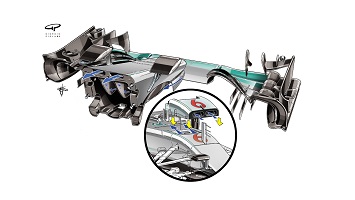
|
formula1.com
03 Apr 2016 . Analysis - Nico Rosberg, wheel to wheel
The Formula One steering wheel evolves year on year, taking on new design and functionality requirements, and adapting to individual driver requests and ergonomic preferences.
In the two drawings above from renowned technical illustrator Giorgio Piola we can see the differences between Nico Rosberg’s 2015 steering wheel and that on his latest Mercedes.
Despite the rule changes for 2016 which dictate that only one paddle may be used to release the clutch for race starts, Rosberg has opted to retain a dual-paddle clutch arrangement (lower red arrows).
The paddles’ shape, however, has been revised, with one - of Rosberg’s choosing - remaining redundant for the start. Similarly the shape of the gear change shifter, as in 2015 mounted on a single central rocker, has been altered to suit the driver, with slightly wider paddles than before (right arrow).
Rosberg’s approach contrasts with that of Ferrari, who as seen previously below have moved to a single-clutch paddle arrangement for 2016 - a move which appeared to pay dividends with their fast starts at the Melbourne season opener.
|
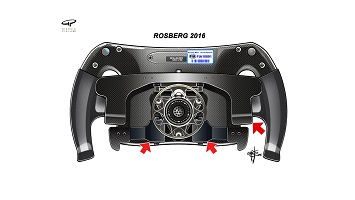
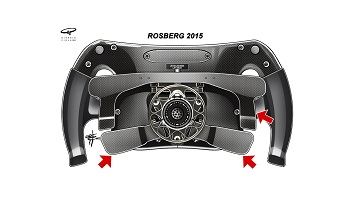
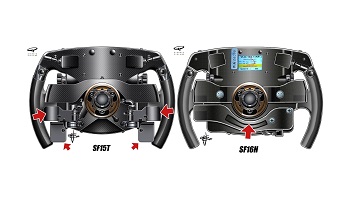
|
formula1.com
04 Apr 2016 . Analysis - Williams’ new shorter nose
Last year Williams were clearly the third-best team. So far this year they are fighting for that position with Red Bull, Toro Rosso and even newcomers Haas.
Among the updates they hope could change all that is this new ultra-short nose which has been in development over the winter and which debuted on Felipe Massa’s car over the Bahrain weekend.
It is far slimmer and more sophisticated than its predecessor, with a small oval inlet at the front that diverts air via short inside channels to the outer edge of the nose. It’s a totally different approach to the S-duct being used by Mercedes and other teams, but like those it helps to energise the airflow around the lower section of the nosecone. Also new on the front wing is the slot in the inner vertical fence.
The new nose was only flown in to Sakhir on Saturday morning, and Massa admitted he had a difficult time finding a balance with it in FP3, hence the team took their time deciding whether to use it for qualifying.
They went with it, and Massa said that it found him some time, even though he was narrowly out-qualified by team mate Valtteri Bottas (using the old nose). Its performance in the race was hard to gauge, given that poor strategy proved Williams’ undoing and that Bottas took a drive-through penalty for his first-lap collision with Lewis Hamilton.
|
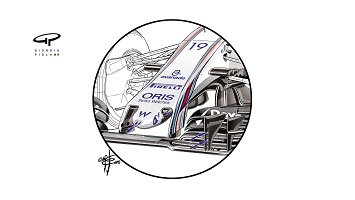
|
formula1.com
06 Apr 2016 . Ferrari’s rear diffuser evolution
In Bahrain Ferrari brought another new update to their rear diffuser. The miniature flaps introduced on the outer rear edges of the diffuser at the end of 2015 (left inset) have undergone a major evolution, with the elements now much larger (main drawing - right inset shows changes from above).
The diffuser’s outer footplate has also grown in size and altered in shape. All these changes work together to help the diffuser produce more downforce. Other revisions to the SF16-H in Sakhir (unseen here) included floor modifications near the vertical turning vanes at the front of the sidepods.
|
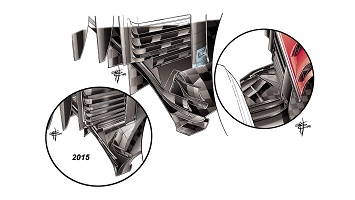
|
formula1.com
17 Apr 2016 . Red Bull clutch paddle arrangement
On the back of their wheels, the British team have kept the same shape and layout seen on Daniel Ricciardo’s and Daniil Kvyat’s 2015 cars, retaining the clutch paddles on either side. To respect the new 2016 rules, the driver may use only one hand and one paddle to operate the clutch at the race start, but both hands may be used at all other times, such as when recovering in the event of a spin.
Despite the regulation changes, nearly all the teams have kept this or a similar layout, with only Ferrari opting to replace the double clutch paddles with a single wishbone arrangement. The previously seen drawing below compares the Scuderia's 2015 and '16 set-ups.
|
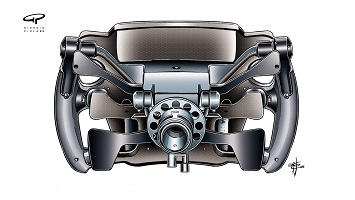
|
formula1.com
18 Apr 2016 . Shanghai tech round-up
Haas VF-16 - front wing update
The front end of Haas’s first Formula One car boasted a revised wing configuration for China, with a new upper flap section (arrow) featuring a very different shape compared to that seen on rival teams’ machines. The VF-16 also had a new monkey seat on its rear wing.
Toro Rosso STR10 - revised rear wing
The Italian team introduced a new rear wing design for the lower downforce demands of the Shanghai International Circuit. Gone is the previous monkey seat (left inset) in the wing’s lower section, while the flap now has an S-shaped rear trailing edge, without the gurney flap seen on the wing used in Australia (top inset).
Red Bull RB12 - serrated front wing
On Friday in China the former champions trialed a front wing featuring a serrated trailing edge on the last two flaps, similar to that which Mercedes debuted at last year’s Japanese race. The experimental design was not used in Saturday practice and qualifying.
|
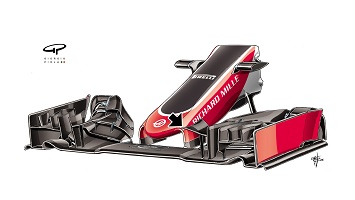
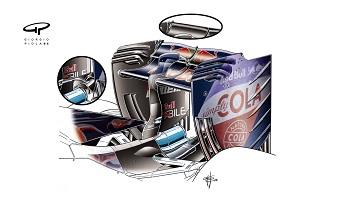
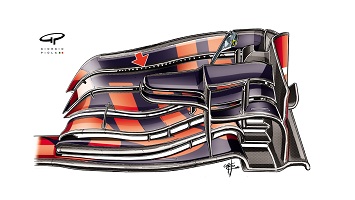
|
21 Apr 2016 . Video - Williams' innovative nose and front wing development
formula1.com
|
|
formula1.com
01 May 2016 . Ferrari wishbone clutch, Mercedes steering wheel settings
Ferrari SF16-H - single wishbone clutch paddle
With the 2016 rules requiring drivers to use only one clutch paddle for the race start, Ferrari have chosen to move away from the traditional double paddle arrangement. We first showed you the Scuderia’s set-up back at round one in Australia, but this alternative angle illustrates how the paddle’s pivot is not in the middle as you might expect, but on one side. This allows for a much longer and adjustable movement compared to the traditional solution retained by other teams.
Mercedes F1 W07 Hybrid - steering wheel labels
The 2016 steering wheels may be largely of similar shape to their 2015 counterparts, but they are becoming much more complex in order to cope with the new rules that limit communication with the pit wall. In essence, far more settings decisions are down to the driver and for the first time here we can see labels featuring question marks on Nico Rosberg’s wheel. One can assume these are to remind the driver to think twice before changing certain critical settings, with the system possibly also asking for additional confirmation before implementing the requested adjustment.
|
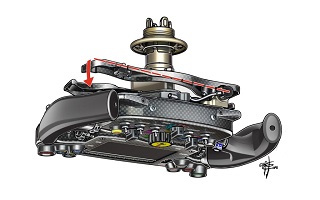
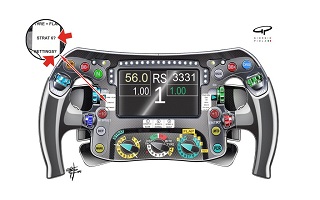
|
formula1.com
02 May 2016 . Sochi tech round-up
Toro Rosso STR11 - rear wing revisions
Toro Rosso again used the rear wing introduced at the previous round in China, though of course with a higher downforce set-up in order to cope with the differing demands of the Sochi Autodrom. The most obvious change is the two horizontal gills in the upper part of the endplate, compared to the four seen in Shanghai.
Ferrari SF16-H - front wing updates
Both Sebastian Vettel and Kimi Raikkonen tested this new front wing configuration in a back-to-back comparison with the previous version (inset). The changes start from the wing’s leading red flap, but become more visible in the white ones behind, with an additional slot to create more downforce.
McLaren MP4-31 - sidepod turning vanes
In Sochi the McLaren featured these new vertical turning vanes, with an L-shaped vane (red arrow) attached to the top of the sidepod, as is the recent trend. The team’s front wing also received an additional fin in its upper flap section.
Mercedes F1 W07 Hybrid - front wing endplate
Seen at Mercedes in Russia was this very innovative and complex endplate for the front wing. Ultimately the team decided not to run it and postponed its debut until the Spanish round in two weeks’ time, where it will form part of a bigger aero package update.
|
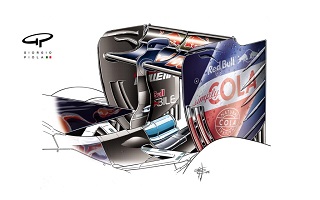
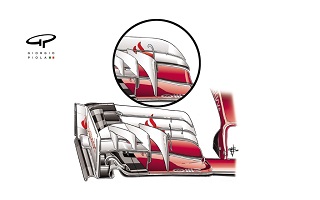
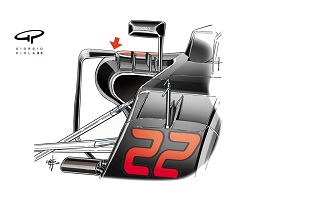
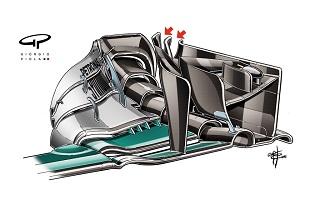
|
formula1.com
15 May 2016 . Mercedes monkey seat updates
World champions - and championship leaders - they may be, but Mercedes show no sign of resting on their laurels. In Barcelona the team have finally debuted the new front wing we showed you last time out in Russia, as well as new turning vanes under the chassis, and - shown below - a new monkey seat on the rear wing. It features an additional slot in its upper section, the primary function of which is to clean up airflow rather than generate downforce.
|
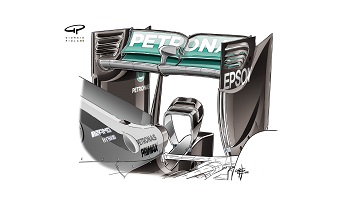
|
formula1.com
17 May 2016 . 3 key updates introduced in Barcelona
McLaren MP4-31 - new front wing
Only Jenson Button had this new-generation front wing, produced by ex-Red Bull aerodynamicist Peter Prodromou. The biggest changes are the much wider flat section beside the endplate (underlined in yellow - compare with the previous version inset) and the big cut (yellow) in the endplate itself. Note that instead of having separate small flaps there are wider chords flaps with a slot (red arrows) in the area close to the centre. Fernando Alonso stuck with the previous front wing, which would have provided the team with useful additional data on the two designs’ relative performance. Both drivers raced with the new brake ducts tested on Friday morning by Button.
Ferrari SF16-H - asymmetric front brakes
Ferrari was among the teams with bigger front brake ducts in Spain. Not only that, they used an asymmetric layout with the three egg-shaped openings seen here on the ‘cake tin’ present only on the right side of the car. These aid the passage of heat from the brakes to the tyre, and helped balance temperatures with the left-front tyre - the one which does the most work around Barcelona.
Force India VJM09 - new front wing
Force India introduced what almost amounted to a B-spec version of their car in Spain, starting with a new chassis given to Sergio Perez, new sidepods and engine cover, and new floor with noticeable changes in the area in front of the rear tyres. Most visible, however, was the difference in the front wing, with a much deeper vertical step (1) in the outer section, which has also become wider (2). The upper flap, too, is new with its curved vertical fin (3), as are the fins (4) in the area beside the endplate, all designed to better manage airflow outside the front tyres.
|
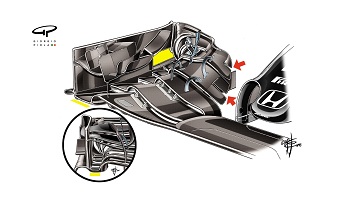
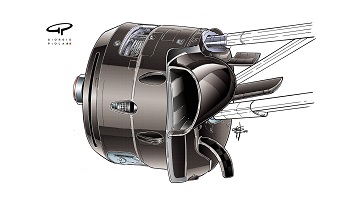

|
formula1.com
29 May 2016 . Monaco tech updates
McLaren MP4-31 - brake duct set-up
With very little time between braking events at Monaco, brake cooling is a big concern. McLaren have kept their new generation of brake duct (main drawing), with a more conventional big ‘paddle’, rather than the previously seen S-shape design (large inset), and with an external ear immediately behind the duct’s inlet to guide the airflow, rather than the previous design where the ear was combined with the inlet (small inset).
Ferrari SF16-H - sidepod openings
Perhaps surprisingly given Monaco’s cooling demands, Ferrari have kept the new, smaller openings in their sidepods, as introduced last time out in Spain (previous, larger version inset). The yellow highlights show how much higher the new inlet is from the ground.
Toro Rosso STR11 - front suspension fin
This clever Toro Rosso update could set a trend. The rules prevent the use of aero devices on suspension arms, but this fin (red arrow) on the front of the STR11 gets around this - it is attached to a cover around the lower wishbone, and that cover is actually part of the brake duct. Hence it complies with regulations in wording, if perhaps not in spirit. The primary function of the brake duct assembly should be cooling rather aerodynamics.
Ferrari SF16-H - front wheel rim heating
To accelerate the warm-up of their front tyres, for the first time the Ferrari wheel rims have these vertical openings (see red arrows) to direct hot air inside the rim itself.
Mercedes F1 W07 Hybrid - brake duct refinements
Mercedes introduced their season’s fifth set of brake duct refinements in Monaco, at the front of the car. The larger top duct can be seen in the main drawing, while the inset shows the solution - with a smaller duct - introduced for Russia and retained for Spain, where the team also debuted sophisticated front-wing endplates with three vertical slots, as well as new turning vanes under the chassis. On Thursday in Monte Carlo, however, both drivers used the wing with the previous endplates.
|
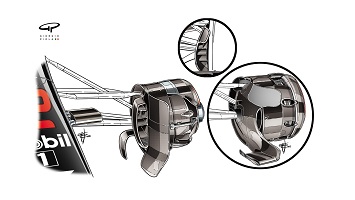
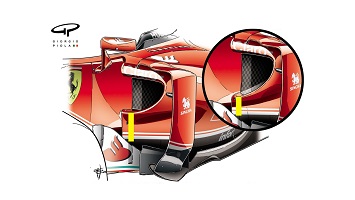
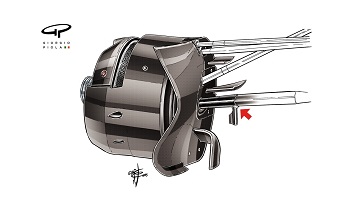
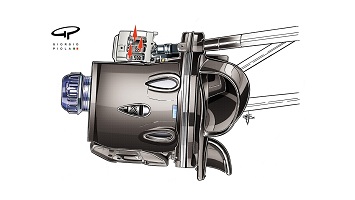
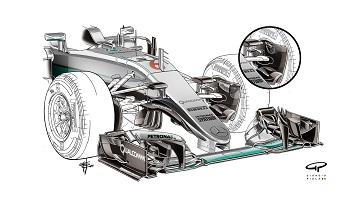
|
formula1.com
12 Jun 2016 . Ferrari’s Montreal engine cover
With its combination of high speeds and numerous heavy braking events, Montreal’s Circuit Gilles-Villeneuve places some rather specific demands on a Formula One car. With the help of renowned technical illustrator Giorgio Piola, we take a look at just one of the changes Ferrari have put in place to help cope…
Since the last round in Monaco, the Italian team have introduced a totally new engine cover and sidepod design. Note in the drawings above how much lower the rear of the new cover is relative to the rear suspension elements (red arrows). The final section of the Montreal cover is also more open than before in order to improve hot air extraction.
|
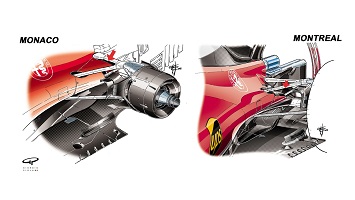
|
formula1.com
13 Jun 2016 . Mercedes’ Montreal updates
Ferrari may be getting closer, but that’s not because Mercedes aren’t trying. Despite winning all bar one 2016 race to date, the reigning world champions show no sign of resting on their laurels, as illustrated by the latest developments seen on their car in Canada...
L-shaped turning vanes
The F1 W07 Hybrid has evolved further since Spain, and has even seen some totally new solutions - like these long, L-shaped turning vanes (left arrow) under the chassis. They exploit the same aerodynamic principles as the vanes already seen under the barge boards in front of the car’s sidepods (below).
Front wing fins
On the front wing’s rearmost flap, Mercedes introduced this unique solution. A series of small parallel fins (red arrow) help to better direct airflow on the outside of the car’s front wheels. It was trialled first on Hamilton’s car, then on Rosberg’s too, the latter also using Canada practice to test a new front wing designed for the low-drag requirements of the upcoming Baku City Circuit race.
|
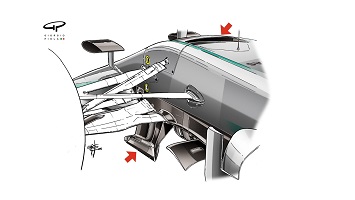
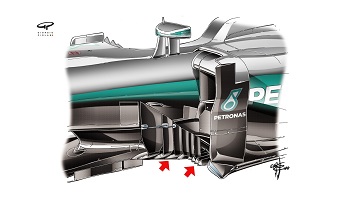
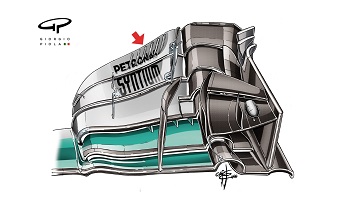
|
formula1.com
19 Jun 2016 . Mercedes’ bowl-shaped Baku wing
The all new Baku City Circuit has become an instant hit with drivers, teams and fans alike, thanks in no small part to its highly unusual nature: a temporary street track, incredibly narrow and slow in places, yet with top speeds in excess of 350km/h. Here’s how Mercedes have approached it in terms of rear aero set-up…
The distinctive looking rear wing above has been used by both Nico Rosberg and Lewis Hamilton in Azerbaijan, having been tested briefly in slightly different form (drawing below) by Rosberg at the previous round in Canada. The main difference is the removal of the monkey seat seen in Montreal (red arrow), in order to reduce drag and improve top speed. On the wing’s trailing edge there is a small Gurney flap to help create a little more downforce in the slow corners.
|
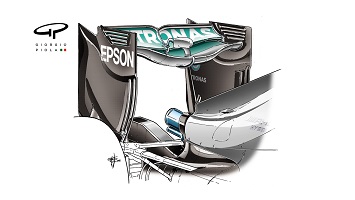
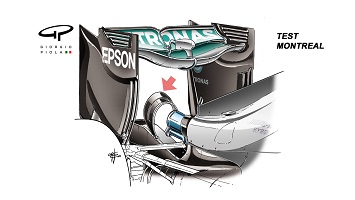
|
formula1.com
20 Jun 2016 . Ferrari’s Azerbaijan aero
In Baku Ferrari introduced a front wing based on the one they debuted back in Russia and used at the last round in Canada (inset). The key difference was that instead of three small chord flaps it featured just two - different in shape and not using the full space allowed by the regulations, meaning lower downforce but less drag.
To balance the new front wing, Ferrari also used a low-downforce rear wing on the SF16-H. The new main plane and flap featured a lower angle of incidence to help boost straight-line speed, while the number of gills on the endplates was reduced.
|
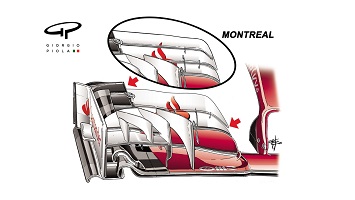
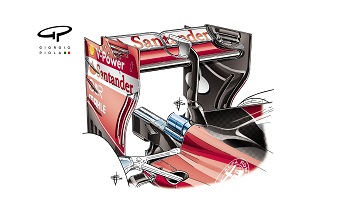
|
formula1.com
03 Jul 2016 . 3 key updates seen in Spielberg
Force India VJM09 - new front wing
In Austria Force India have introduced this front wing, based on the new-generation design first seen in Spain. The main difference is the shorter last two flaps, a change made in order to reduce front downforce to better suit the demands of the Red Bull Ring. The yellow highlight shows how much longer the flaps were previously.
Haas VF-16 - blown front axle
Blown axles are a not uncommon feature in F1 racing - this season teams including Haas, Red Bull, Ferrari, McLaren, Force India and Toro Rosso have used them. Passing air through the axle helps engineers to modulate brake, wheel, and thus tyre temperatures. However, the solution also creates extra drag and at some circuits - such as Spielberg - that is undesirable, hence Haas's move here to cover off the opening (red arrow).
McLaren MP4-31 - new rear wing
On Friday morning in Austria Fernando Alonso tested this new rear wing. Its radical looking endplates feature extremely long vertical slots towards the rear, with further slots at the front to help manage the airflow passing between them. To stiffen the assembly, three horizontal strakes have been added across the width of the endplate. However, it seems that wasn’t enough to guarantee a constant level of downforce, hence the wing wasn’t used for qualifying or race. It’s possible, though, that we may see a modified version at Silverstone next week.
|
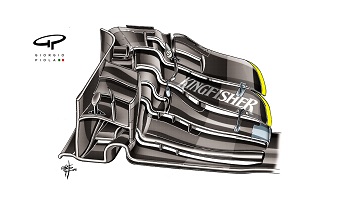
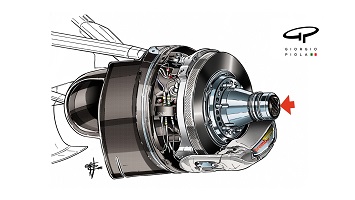
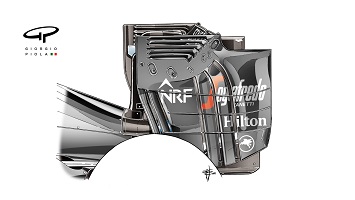
|
formula1.com
04 Jul 2016 . Mercedes' strengthened rear suspension
Understandably Mercedes did not want to risk a repeat, and by the start of qualifying just a couple of hours later this safeguard was in place, with carbon fibre strips applied to the top wishbone, pull rod arm, and front leg of the lower wishbone. The stiffening was applied to both cars and the modification was retained for the race.
|
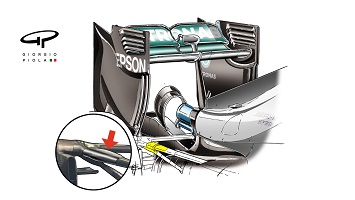
|
formula1.com
05 Jul 2016 . Williams' new front wing
The upper flap now has a twisted inner endplate (1) similar to that seen on the Toro Rosso. Previously it was vertical and straight. There is an additional fin (2) to better direct airflow to the outside of the wing, and the central vertical plate is now slotted (3) whereas before it was closed. And the horizontal fin on the endplate (4) is now twisted rather than straight.
Massa was due to race with the wing, but at the last minute the team discovered some structural damage - thought to have been caused by vibrations over kerbs in qualifying - meaning the Brazilian had to start from the pit lane after a nose change.
|
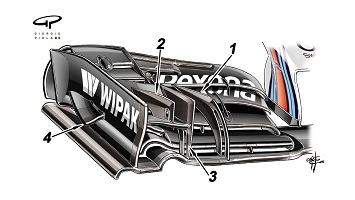
|
formula1.com
10 Jul 2016 . Williams’ Silverstone aero updates
Williams have retained the dramatic-looking rear-wing endplates that they introduced last time out in Austria. They now feature a different vertical straked section at the bottom rear, designed to better manage the airflow vortices coming off the car.
Friday in Great Britain saw both Williams drivers test the new front wing that was debuted - but ultimately not raced - on Felipe Massa’s car in Austria. Here it has been integrated with the more squared vertical nose pillars (inset) used in Canada, but not seen since on the FW38. However, both Massa and Valtteri Bottas reverted to the previous wing (as raced in Spielberg) for Silverstone qualifying and race.
|

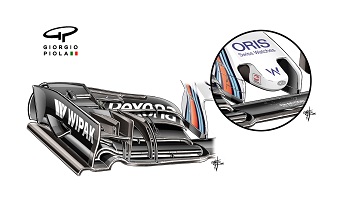
|
formula1.com
11 Jul 2016 . Ferrari’s Silverstone updates
At the front of the car, Ferrari altered the wing used last time out in Spielberg (upper drawing) by modifying the endplate (lower drawing). The differences - at the rear - are subtle but important, with the upward sloping shape very similar to that used by Mercedes up until Spain and copied by other teams. Its purpose is to better manage airflow around the front tyres.
Meanwhile, underneath the car we could see these quite new chassis fins (red arrow), far more sculpted shape than the simple horizontal flaps normally seen in this area. Also new were modified brake ducts. The team will have the chance for further on-track development work at this week’s in-season test at Silverstone, where Kimi Raikkonen will be driving alongside young F1 hopeful Charles Leclerc.
|
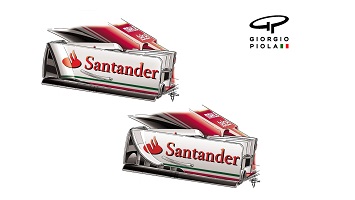

|
formula1.com
24 Jul 2016 . loving the louvres in Hungary
Sauber (above, upper arrow) and Mercedes (below) have both followed the example set by Toro Rosso at the start of the season with these rear wing endplate shapes, the top section featuring open louvres to help control airflow. Mercedes also used this high-downforce solution last time out at Silverstone, where Sauber conducted shakedown testing with theirs. Sauber’s design also has slots (lower arrow) similar to those introduced by Red Bull and seen on other cars including the Ferrari.
|
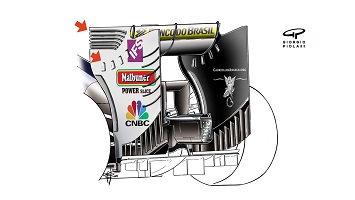
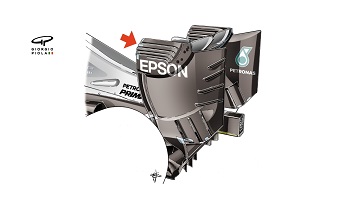
|
formula1.com
26 Jul 2016 . what was hot in Hungary
Red Bull RB12 - monkey seat
For the first time this year, the Hungarian round saw Red Bull introduce a monkey seat to their rear wing set-up. Initially only Daniel Ricciardo ran it, while Max Verstappen sampled the revised endplates seen here with upward strakes at the rear. Then from Saturday both drivers opted for this new assembly, combining both the monkey seat and the updated endplates.
Mercedes F1 W07 Hybrid - optimized cooling
Along with Malaysia, Hungary is usually one of the hottest races of the year, hence Mercedes’ decision to maximize their car’s cooling for the Hungaroring. Here we can see how they increased the size and height of these openings - complete with bulged fairings - on top of the sidepods beside the cockpit.
Ferrari SF16-H - rear diffuser updates
In their bid to close the gap to Mercedes - and indeed stay in touch with Red Bull - Ferrari brought this new rear diffuser configuration to Budapest, adding new solutions to the now standard flap cascade (inset) which they introduced in Austin last year. Note the new long and angled fin (arrows), designed to create vortices in this delicate area of airflow.
|

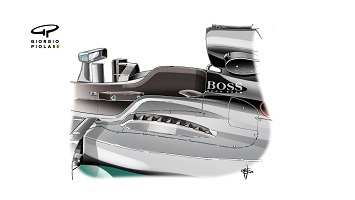
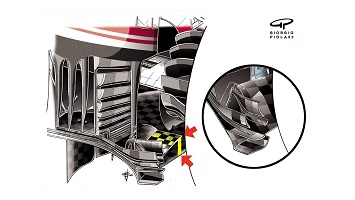
|
formula1.com
02 Aug 2016 . Floor developments dominate at Hockenheim
In Hungary Williams introduced a new floor to the FW38 as part of a raft of measures aimed at improving performance, but with just one available it was only used on Valtteri Bottas’s car. However, in Germany both Bottas and Massa had the new-spec floor available to them, and both ran it with the latest nose and front wing assembly that was introduced but not used in Budapest.
The new floor features three new L-shaped slots (indicated by the red arrows) compared to the old solution (inset), but has one less slot at the rear of the floor.
The new slots are similar to those introduced by Toro Rosso in 2015, with Mercedes one of the teams to have taken on a similar design.
The idea behind the three slots is to clean up airflow that has been diverted laterally by the rear tyre deforming under load - a phenomena that can inhibit diffuser performance.
McLaren took a leaf out of Red Bull’s book in Germany with the introduction of a new ‘Batman’ winglet (indicated by the red arrow) just above the tea tray underneath the front of the chassis.
The purpose of this aerodynamic addition, which was trialled on Fernando Alonso’s car during FP2, is to improve airflow along the length of the car, particularly around the sidepods. Red Bull have used a similar device since the start of the season.
In a bid to improve downforce, Toro Rosso introduced some alterations to the floor of the STR11 in Germany, the most prominent of which was to the inboard fin just ahead of the rear tyres.
In contrast to before, this fin now has a slot in the middle of its length, thereby allowing air (yellow arrow) to move more efficiently around the rear tyres and towards the brake ducts.
In Germany Ferrari retained the rear diffuser updates introduced in Hungary. This drawing offers another view of the innovative long fin (indicated by the red arrow) on the external section of diffuser, inside the rear tyres, which has been designed to create a vortex in order to improve efficiency of the extraction of air from under the diffuser section.
|
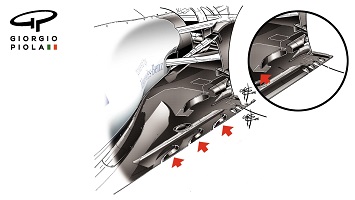
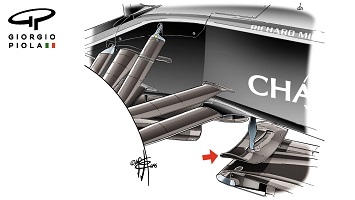
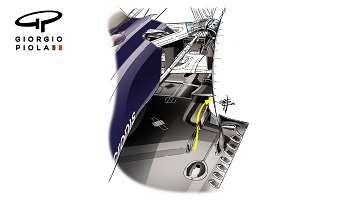

|
formula1.com
08 Aug 2016 . Mercedes’ unique brake discs
With the brakes on an F1 car regularly exceeding 1,000 degrees C, dissipating heat efficiently is a major concern in order to keep the brakes working effectively over a sustained period of time. Mercedes' latest development - giving their brake discs a concave/scalloped edge - is a move that has likely been made to improve cooling efficiency, with the revised shape (believed to be an F1 first) enlarging the surface area of the disc and improving fluid dynamics within the brake drums. On top of a direct performance advantage, improved heat dissipation helps the disc stay in an operating 'sweet spot' - which has an additional benefit in terms of tyre temperatures.
|
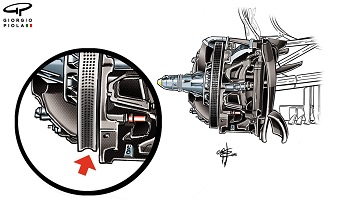
|
formula1.com
09 Aug 2016 . Toro Rosso’s revised front wing
More than just generating downforce, the front wing sets the tone for airflow downstream, so it’s perhaps unsurprising that it is one of the most developed parts of any F1 car. At Hockenheim Toro Rosso introduced a new-spec front wing as one of a number of performance enhancing developments. In fact, the Italian team added so many new parts - including a revised floor, new brake ducts and updated sidepod turning vanes - that the STR11 was almost a B-spec.
Of the many tweaks made to the front wing, the most obvious is the addition of a little fin (indicated by the black arrow) which replaces the arched section of the previous version. Smaller revisions, including changing the shape of the endplate’s trailing edge, should help improve airflow around the front tyres - a key factor for improving aero performance along the car.
|
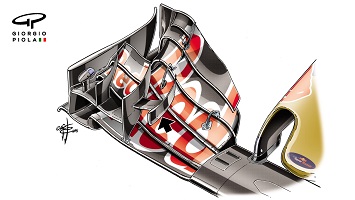
|
formula1.com
28 Aug 2016 . key aero updates in Belgium
Sauber C35 - new nose and front wing
With the recent purchase of the team finally freeing up much-needed development funds, Sauber debuted what almost amounted to a B-spec car in Belgium, starting with this totally revised front wing. While the shape of the nose (1) is unchanged, the pillars (2) are very similar to those on the McLaren, with a vertical tail in their lower section. The wing itself features six full-length flaps, following Red Bull’s design philosophy, while the upper flaps (3) are again closer in shape to those seen previously on the McLaren. Finally, the large step at the base of the endplate (4) apes the shape used by Mercedes.
Toro Rosso STR11 - updated front wing
Toro Rosso brought two front wings to Belgium, both based on the new design introduced at the last race at Hockenheim. The key differences are the last flap, which features a reduced chord (inset) and one cut-off element (rearmost in main drawing) that was used for qualifying and the race.
Ferrari SF16-H - rear wing configurations
Friday in Belgium saw Ferrari using a low-downforce rear wing as seen in Baku (left drawing). But for qualifying and race they opted for more downforce, with a wing (right drawing) featuring four gills on the top of endplates, and bigger wing elements and flaps, with a greater angle of incidence. It proved a good solution on Saturday, but its real value could be over Sunday’s race distance when the team want to place less stress on their tyres.
|
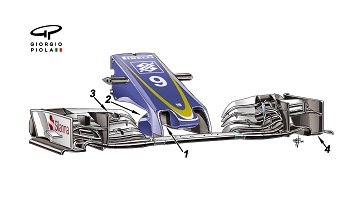


|
formula1.com
Red Bull’s low-downforce Spa set-up . 30 Aug 2016
Red Bull were the only team to opt for a very low-downforce set-up. In the drawing above we see the rear wing was even smaller than the one they used for the Russian race in Sochi. The main plane and flap have a shorter chord and a lower angle of incidence, whilst on the endplates the diagonal strakes have been removed - all reducing downforce and cutting drag.
It was a similar story with the front wing, as shown in the drawing above. For Spa, Red Bull brought back the experimental design tested briefly earlier this year in China, when it featured a serrated second flap (red arrow, left). Here it was reintroduced with a shorter chord to the final flap (red arrows) and minus the serration. Both Ricciardo and team mate Max Verstappen had this configuration for qualifying and race.
|
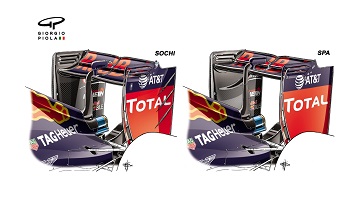
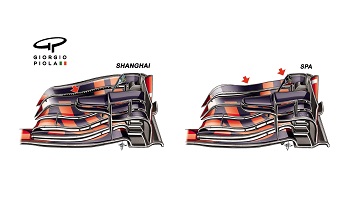
|
formula1.com
making the most of Monza . 05 Sep 2016
Ferrari SF16-H - front wing updates
Ferrari had two front wing options available for their home race. They chose the one shown above, without the longitudinal fin inside the endplate that was raced last time out in Belgium (inset). The red arrow on the main drawing highlights the lack of a final flap and the adjustment mechanism used to alter the angle of incidence.
Red Bull RB12 - Monza-Spa rear wing comparison
The rear wing that Red Bull introduced in Italy was very much based on the design the team ran in Monza last year - rather than the one they used last time out at Spa. As can be seen in the drawing above, among the most notable differences is the total lack of strakes or vertical gills in the endplates. Also different are the central wing support and the DRS mechanism.
Renault R.S.16 - rear bodywork trial
On Friday in Italy, Jolyon Palmer got the job of testing this revised bodywork on the rear of his Renault. The ‘cola bottle’ section is much narrower and lower than before, and it ends with an incredibly big opening, which allows all the hot air to exit only at the very back of the car.
|

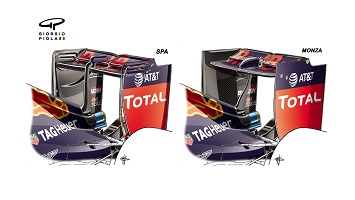
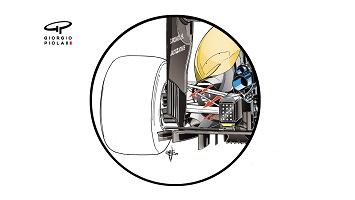
|
formula1.com
Mercedes suspension in Singapore spotlight . 20 Sep 2016
Mercedes F1 W07 Hybrid - front suspension packaging
Be it due to possible correspondence between rival teams and the FIA, or simply specialist media speculation, Mercedes’ front suspension was in the spotlight again in Singapore - even though it’s a layout first seen at the Chinese round earlier in the season. The talking point was the packaging of the team's innovative, hydraulic third suspension element (inset, above), housed transversely in the upper chassis bulkhead, which facilitates better control of ride height and roll.
Mercedes have pushed the regulations to the limit here, cleverly utilizing both a dimensional allowance added last year so that Manor (then Marussia) could use an adapted version of their previous season’s car, and the familiar vanity panel (see drawing above) on top of the chassis - originally introduced to cars in 2013 to smooth out the infamous ‘stepped’ noses. This aggressive interpretation of the rule book has allowed the world champions to house their complex suspension componentry - and critically the access needed to adjust it - high in the chassis, whilst still respecting the regulations on chassis height. Other teams have a third suspension element (though few are hydraulic) and most still use a vanity panel for suspension access, but none has been so extreme in their design philosophy.
Interestingly, since the Hungarian round in July, Mercedes have also placed a cover (right arrow, above) on top of the hydraulic damper, effectively hiding it from view when the vanity panel is removed. (The left arrow shows the pipes used to check the pressure in the braking system.)
|
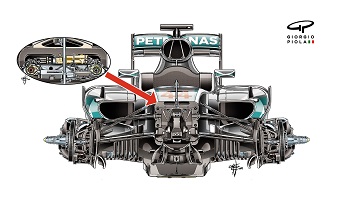
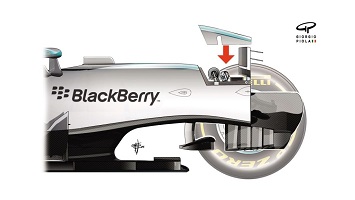
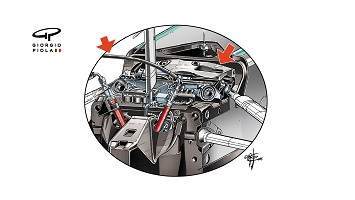
|
formula1.com
Mercedes test a first in front wing development . 01 Oct 2016
On Friday in Malaysia they briefly trialled an interesting development obviously aimed at next season - and one never seen before. Shown above, this new front wing looks unremarkable at first glance. Look closer and you will see the endplate is totally separate to the main plane (red arrow, yellow highlight). Not dissimilar concepts have been used before on rear wings - Toro Rosso introduced open gills at the top of their rear endplates, an idea then copied by Sauber, and seen at Sepang on the McLaren. However, at the front it is far more difficult, with huge implications for stiffness and flexibility - something that is rigorously checked with a specific FIA deflection test. The advantages will come from the solution’s sophistication in controlling the airflow vortices on the side of the wing.
|
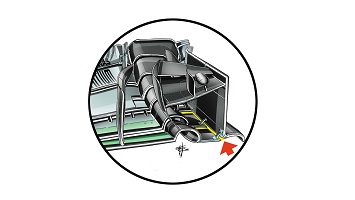
|
formula1.com
Ferrari under-chassis aero . 04 Oct 2016
Ferrari, chasing Red Bull hard for second in the standings, trialled a new updated aero package on the SF16-H during opening practice in Malaysia, no doubt with the upcoming Japanese race in mind. The drawing above shows the addition of a ‘batman’ wing (left arrow) just behind the front suspension, similar to the one introduced in Austin last year, and longer vertical fins (right arrow) along the edge of the T-tray. This was used in practice only: for qualifying and the race the team reverted to the standard solution shown below, with a vertical, V-shaped fin under the chassis (top arrow) and shorter vertical fins (bottom arrow) on the T-tray.
|
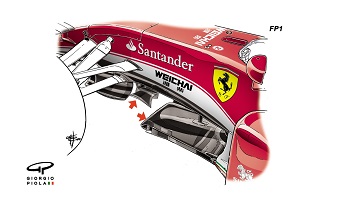
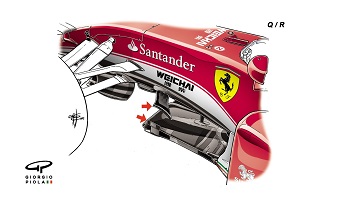
|
formula1.com
McLaren rear wing developments . 05 Oct 2016
The big technical news for McLaren in Malaysia was the introduction of an upgraded power unit that Fernando Alonso ran in practice. But the Woking team also used this new endplate on their rear wing in both qualifying and race, having previously trialled it on Alonso’s car only in Singapore. The team have adopted the open gills at the top leading edge of the endplate - an idea introduced by Toro Rosso at the launch of their 2016 car, and subsequently adopted by Sauber and Mercedes.
|
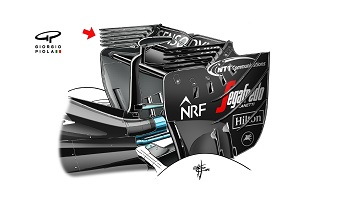
|
formula1.com
Ferrari front wing pillars . 09 Oct 2016
All weekend the Italian team have been using the new front wing that they tested briefly last time out along with other aero updates in Malaysia. At first sight the most relevant difference is the pillars which connect the wing to the nose of the SF16-H. As can be seen in the right-hand drawing, these are now longer at the rear (yellow highlight), with a shape similar to those seen on the McLaren. Also different are the turning vanes under the nose, which now feature three elements instead of two, and are no longer attached in the first section of the nose cone. The revisions have also no doubt been made with 2017’s revised aero regulations in mind.
|
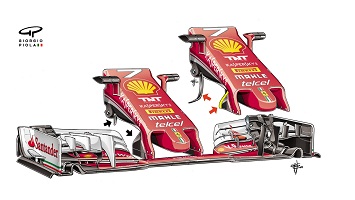
|
formula1.com
Ferrari and McLaren Suzuka updates . 11 Oct 2016
In addition to the updated aero package already tested briefly at the previous round in Malaysia, Ferrari introduced the new front wing above. The only difference over the previous design is a small but important one - the horizontal fin in the footstep area inside the endplate (inset, yellow highlight) has been removed. Of course, the new wing was mounted on the modified nose and pillars as previously seen here.
Slightly further back on the SF16-H, Ferrari repeated a similar update (above) to that seen in Austin last year (below), introducing new turning vanes under the chassis with three rather than two elements, and the addition of a horizontal ‘batman’ wing, all in order to improve the car’s aero balance.
And at McLaren the team again used the new front wing below which they debuted on the MP4-31 in Malaysia, now with much wider slots between all 10 elements, and a much broader footstep area just inside the endplate.
|
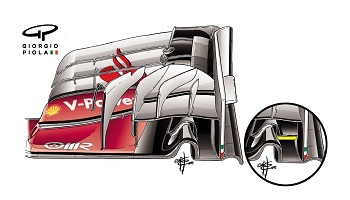
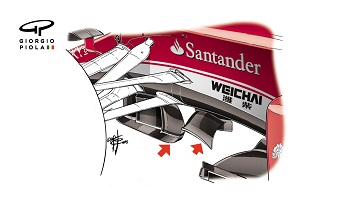
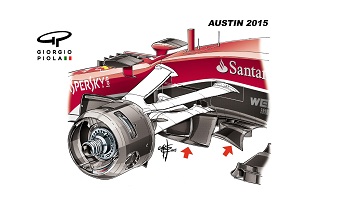
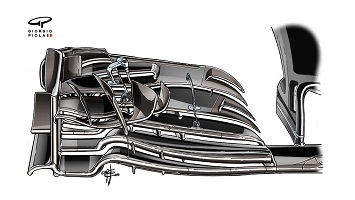
|
formula1.com
McLaren’s engine cover camera . 22 Oct 2016
On the back of the car were various monitors (yellow) to measure deflection. Highlighted here is a small camera (red arrow) mounted on top of the rear suspension upright and pointed at the engine cover, to allow the team see how the cover is affected by deformation and heat. To make the images from the camera clearer and easier to analyse, a thin mesh skin (silver area) was also applied to the cover. This work is unlikely to lead to major changes on this year’s car, but could provide data invaluable to the development of next year’s.
|
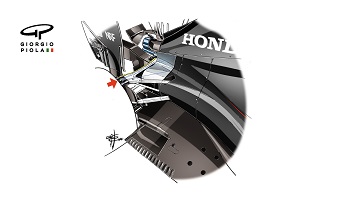
|
formula1.com
2017 testing well underway in Austin . 24 Oct 2016
McLaren MP4-31 - front wing development
Like Mercedes, McLaren have been trialling front wing developments and this revised solution looked very much like a first step towards what could well be seen on the Woking team’s 2017 machine. As with Mercedes, the big changes are concentrated on the outer part of the wing, as this is the area - beside the endplate, in front of what will be wider tyres next year - crucial to controlling airflow over and around the front wheels. Highlighted in yellow, you can see the footstep near the endplate is gone, with the main plane now almost totally flat - without the previous U-shape (red arrow). Note also the extra vertical fences under the main plane. McLaren also caught engineers’ eyes in Austin with their engine cover camera.
Mercedes F1 W07 Hybrid - floating front wing endplate
In Austin it was Nico Rosberg’s turn to run the innovative endplate design seen briefly on team mate Lewis Hamilton’s car at the previous round in Malaysia. This front-on view from below the wing clearly highlights (in yellow) how the main plane is detached from the endplate for around the first 20cm.
McLaren MP4-31 - rear diffuser
It wasn’t just the front of the car coming under McLaren’s consideration in Austin. At the rear the team are still pushing hard with development work, including this new diffuser with a return to two vertical splitters (red arrow), not dissimilar to those seen in the days of the blown diffuser.
Ferrari SF16-H - T-tray winglet
On Friday in Austin Sebastian Vettel tested a different configuration of under-chassis aero, with the winglet shown here (red arrow, left) no longer attached to the car’s underside, but instead attached directly to the T-tray (area indicated by dotted red arrow) as Red Bull and McLaren have been doing this season. Unfortunately, heavy vibrations over kerbing caused the winglet to detach whilst on track, forcing Vettel to revert to the previous layout, as tested in Malaysia and race in Japan.
|
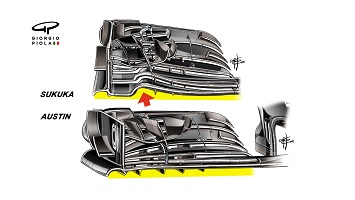
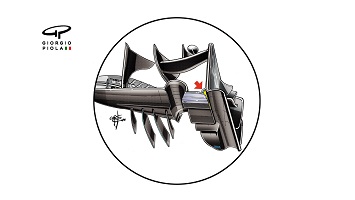

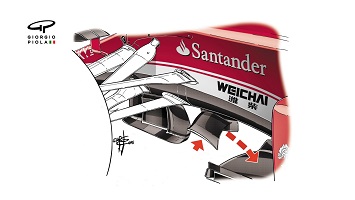
|
formula1.com
McLaren’s 2017 front wing concept . 29 Oct 2016
It’s a fresh concept and one likely to be among a whole new family of front wings for 2017, when the F1 technical regulations change significantly. Among the most noticeable changes will be wider tyres - and wider tyres mean more drag, the effects of which teams will be trying to mitigate through their front wing designs. This drawing shows the underside of the configuration McLaren tested in Mexico. The old curved section (inset) near the endplate has gone, with the main plane now straight (1 and inset) and generally lower towards the outer edge. The only feature that remains largely unaltered is the small arch (2) on the outside of the endplate, while the biggest change is the vertical fences (3) under the wing - there are now four instead of two, and all are very straight.
|

|
formula1.com
Mercedes 2017 brake development . 13 Nov 2016
We have already looked at their radical new front wing endplate, while this experimental brake set-up was trialed in Friday morning free practice in Monza, Austin and Mexico - all circuits with very long straights and hence very heavy braking events. The team have added two additional spacers (1), one on either side of the Carbon Industries brake disc, both made of the same friction material as the disc. They are mounted very close to the disc using a special frame (2) - the shape of which is clearer in the drawing below - and are cooled by the inside of the brake duct (3).
It is difficult to know the exact purpose of this solution. It could be to provide better brake temperature and bite at the beginning of the braking area, or it could be to dissipate heat away from the discs by transferring it to the spacers, which have their own cooling holes and dedicated duct (see blue arrows). It is also possible the set-up is designed to simulate the slightly wider brake discs that will become legal for 2017, allowing the team to study the thermal impact on the brakes and the tyres.
|
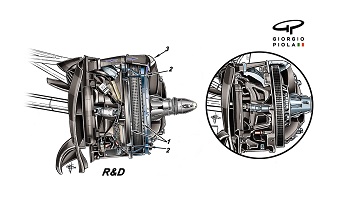
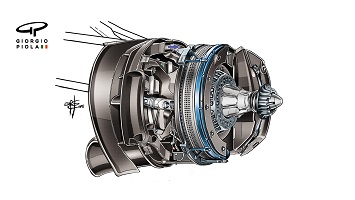
|
formula1.com
the changes to help Hamilton combat start woes . 15 Nov 2016
Standing starts have been a real issue for Hamilton this year, with the Briton losing multiple positions off the line. As recently as Japan Hamilton dropped six places from his starting position, putting him firmly on the back foot and prompting an in-depth look into what could be done to help him. As this illustration indicates, Mercedes have made a couple of key ergonomic changes, with the team modifying the shape and positioning of the clutch and gear-change levers behind the wheel. The up-shift gear-change paddle (left arrow) has a new extension very similar to the one used by team mate Nico Rosberg last season, bringing it closer to the clutch (right arrow), which has been given a triangular-shaped wedge grip to improve finger control. Sadly, with the Interlagos race starting under the safety car, we didn’t get to evaluate the efficacy of Mercedes’ latest modifications.
|
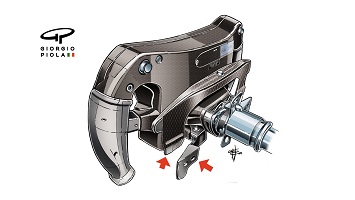
|
formula1.com
unique Ferrari exhaust, Red Bull T-tray wing . 27 Nov 2016
Ferrari SF16-H - solid-block exhaust
Ferrari have a very expensive and complex the way of building their exhaust system. Unlike most other teams’, it is not formed from tubing but is instead machined from a solid block of metal, making it lighter and more reliable. It’s a solution that has been on the SF16-H since the team’s home race at Monza in September.
Red Bull RB12 - T-tray wing mounting
Red Bull were the first team this season to modify the fixing point of the bat wing (red arrow) introduced in 2014 by Mercedes. Instead of being attached to the lower part of the chassis, it is fixed to the T-tray - a solution since copied by McLaren and Ferrari.
|
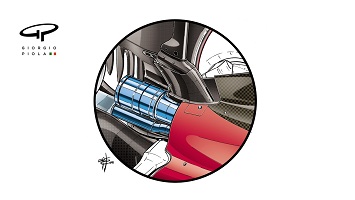
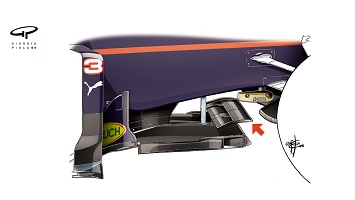
|
|